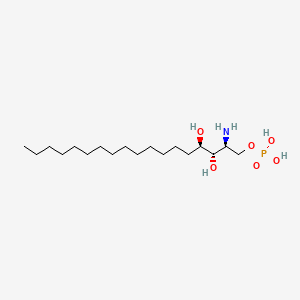| Authors | Title | Published | Journal | PubMed Link |
|---|---|---|---|---|
| pmid: | ||||
| Vandenbosch D et al. | Phytosphingosine-1-phosphate is a signaling molecule involved in miconazole resistance in sessile Candida albicans cells. | 2012 | Antimicrob. Agents Chemother. | pmid:22354293 |
| Lee JP et al. | Phytosphingosine-1-phosphate represses the hydrogen peroxide-induced activation of c-Jun N-terminal kinase in human dermal fibroblasts through the phosphatidylinositol 3-kinase/Akt pathway. | 2012 | Arch. Dermatol. Res. | pmid:22566145 |
| Candelore MR et al. | Phytosphingosine 1-phosphate: a high affinity ligand for the S1P(4)/Edg-6 receptor. | 2002 | Biochem. Biophys. Res. Commun. | pmid:12270137 |
| Kim MK et al. | Sphingosine-1-phosphate stimulates rat primary chondrocyte proliferation. | 2006 | Biochem. Biophys. Res. Commun. | pmid:16674917 |
| Inagaki Y et al. | Sphingosine 1-phosphate analogue recognition and selectivity at S1P4 within the endothelial differentiation gene family of receptors. | 2005 | Biochem. J. | pmid:15733055 |
| Dickson RC and Lester RL | Metabolism and selected functions of sphingolipids in the yeast Saccharomyces cerevisiae. | 1999 | Biochim. Biophys. Acta | pmid:10366774 |
| Jin YX et al. | A strategy for enrichment of the bioactive sphingoid base-1-phosphates produced by Hypericum perforatum L. in a balloon type airlift reactor. | 2012 | Bioresour. Technol. | pmid:22940331 |
| Valentijn-Benz M et al. | Sphingoid bases inhibit acid-induced demineralization of hydroxyapatite. | 2015 | Caries Res. | pmid:25300299 |
| Kim MK et al. | Phytosphingosine-1-phosphate stimulates chemotactic migration of L2071 mouse fibroblasts via pertussis toxin-sensitive G-proteins. | 2007 | Exp. Mol. Med. | pmid:17464180 |
phytosphingosine 1-phosphate
phytosphingosine 1-phosphate is a lipid of Sphingolipids (SP) class. The involved functions are known as sphingolipid metabolism, Gene Expression, Cell Death, Signal Transduction and inhibitors. Phytosphingosine 1-phosphate often locates in Body tissue, Head, Cytosol, Membrane and membrane fraction. The associated genes with phytosphingosine 1-phosphate are Homologous Gene, NRG1 gene, Genes, Mitochondrial and G Protein Gene. The related lipids are Sphingolipids, Phosphatidic Acid and Membrane Lipids.
Cross Reference
Introduction
To understand associated biological information of phytosphingosine 1-phosphate, we collected biological information of abnormalities, associated pathways, cellular/molecular locations, biological functions, related genes/proteins, lipids and common seen animal/experimental models with organized paragraphs from literatures.
What diseases are associated with phytosphingosine 1-phosphate?
There are no associated biomedical information in the current reference collection.
No disease MeSH terms mapped to the current reference collection.
PubChem Associated disorders and diseases
What pathways are associated with phytosphingosine 1-phosphate
There are no associated biomedical information in the current reference collection.
PubChem Biomolecular Interactions and Pathways
Link to PubChem Biomolecular Interactions and PathwaysWhat cellular locations are associated with phytosphingosine 1-phosphate?
Visualization in cellular structure
Associated locations are in red color. Not associated locations are in black.
Related references are published most in these journals:
| Location | Cross reference | Weighted score | Related literatures |
|---|
What functions are associated with phytosphingosine 1-phosphate?
Related references are published most in these journals:
| Function | Cross reference | Weighted score | Related literatures |
|---|
What lipids are associated with phytosphingosine 1-phosphate?
Related references are published most in these journals:
| Lipid concept | Cross reference | Weighted score | Related literatures |
|---|
What genes are associated with phytosphingosine 1-phosphate?
Related references are published most in these journals:
| Gene | Cross reference | Weighted score | Related literatures |
|---|
What common seen animal models are associated with phytosphingosine 1-phosphate?
There are no associated biomedical information in the current reference collection.
